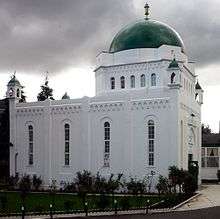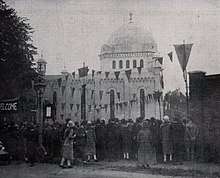Fazl Mosque, London
The Fazl Mosque, also known as The London Mosque, is the first purpose-built mosque in London, England. It was opened on 23 October 1926 in Southfields, Wandsworth. At a cost of £6,223, the construction of the mosque and the purchase of the land on which it stands, was financed by the donations of Ahmadi women in Qadian, Punjab, British India,[1][2] with support from the British Muslim convert Khalid Sheldrake.[3] Between 1984 and 2019 the Fazl Mosque was the residence of the caliphs of the Ahmadiyya Community, and therefore its de facto international headquarters. The administrative headquarters now lies at the site of the Mubarak Mosque.[4]
| Fazl Mosque | |
|---|---|
 Side view of the mosque | |
| Religion | |
| Affiliation | Islam |
| Branch/tradition | Ahmadiyya |
| Leadership | Mirza Masroor Ahmad |
| Location | |
| Location | London, England |
| Geographic coordinates | 51°27′04″N 00°12′27″W |
| Architecture | |
| Architect(s) | Thomas Mawson |
| Type | Mosque |
| Style | Indo-Saracenic architecture |
| Completed | 1926 |
| Specifications | |
| Dome(s) | 1 |
| Minaret(s) | 0 |
| Website | |
| thelondonmosque | |
History
.jpg)
The design of the mosque is credited to Thomas Mawson.[5][6] The plans form part of the Mawson archive held by the Cumbria Archive Service.[7]
The foundation stone was laid in 1924 by Mirza Bashir-ud-Din Mahmud Ahmad, the second Caliph, who was visiting London as the representative of Islam at The Conference of Living Religions that was being held at the Imperial Institute in South Kensington. 200 guests attended the foundation ceremony. Building of the mosque began in September 1925 and was completed 10 months later. It was named the Fazal Mosque by the Caliph (Fazal meaning Grace).

The mosque was due to be formally opened by Prince Faisal of Saudi Arabia who, however, was stopped from doing so by the Foreign Secretary of the King of Saudi Arabia only a few hours before the ceremony was to start.[8][9] The planned inauguration, nevertheless, went ahead and Khan Bahadur Sheikh Adbul Qadir, ex-Minister of Punjab Legislative Council, formally opened the mosque on 4 October 1926. 600 distinguished guests representing numerous countries, as well as local MPs and other dignitaries attended the ceremony and the function was well reported in the press.[10][11][12]
The mosque accommodates 150 worshippers and is also known colloquially among Ahmadis as the London Mosque. Its first Imam was Maulana Abdul Rahim Dard and its first muezzin (caller to prayer) was Mr Bilal Nuttall. Since 1926 the London Mosque has had eleven Imams. The current incumbent is Ata'ul Mujeeb Rashid who has served as Imam since 1983.
Caliph's residence
.jpg)
In 1984 the Government of Pakistan promulgated Ordinance XX which prohibited Ahmadis from any public expression of the Islamic faith, rendering the caliph unable to perform his duties as the leader of the Community. In response Mirza Tahir Ahmad, the fourth caliph, left Pakistan and migrated to London, provisionally moving the Ahmadiyya headquarters from Rabwah, Pakistan to the Fazl Mosque in London.[13][14][15]
Within the mosque complex, a separate building consisting of a hall, offices, and a small apartment on the top floor for the Imam of the mosque was built beside the mosque earlier in 1967. Upon his migration, this apartment became the home of the caliph and following his death in 2003, the home of Mirza Masroor Ahmad, the fifth and current caliph. It remains the permanent residence of the caliph as of 2016. The mosque and its surrounding buildings have therefore become the international headquarters of the movement since 1984.
Influence
In addition to the usual flow of MPs, mayors, councillors, scholars and students, The London Mosque has hosted a number of distinguished visitors from far and wide. The founder of Pakistan, Muhammad Ali Jinnah, visited the mosque several times and made his famous speech in its grounds when he decided to return to India to represent the Muslims in the sub-continent. The Crown Prince of Saudi Arabia, Faisal Bin Adbul-Aziz also visited the mosque in 1935 as did his predecessor, King Saud.[16]

Sir Chaudhry Muhammad Zafarullah Khan, the first Foreign Minister of Pakistan, a President of the International Court of Justice and President of the United Nations General Assembly, lived at the premises for many years. In July 2011 Prince Edward, Earl of Wessex of the UK also visited the mosque in his capacity as a Patron of ‘The London Gardens Society’ and thus took the opportunity to inspect the gardens of the Fazl Mosque, which have won numerous awards over the past few years. The Earl was also able to view a small exhibition about the history of the mosque.[17]
In 1955 the second Caliph of the Ahmadiyya movement returned to the mosque when he visited Europe for further medical treatment after he was physically attacked in Rabwah, Pakistan. In London he also held a conference of all missionaries stationed in Europe. The third Caliph also visited the mosque many times.
Expansion
As the range and frequency of activities in the mosque progressively increased there was need for more space. This increase saw the construction of the multi-purpose Mahmood Hall, as well as the Nusrat Hall, in the grounds of the mosque. From Sunday school classes and school visits, to question and answer sessions and international meetings, The London Mosque has been and continues to be a hive of activity promoting education and religious awareness.
From the premises of the mosque, the fourth Caliph was also able to launch the community's satellite TV channel Muslim Television Ahmadiyya International (MTA) in 1994 through which he could transmit televised messages globally to the community and have his sermons heard throughout the world.
With the expansion of The Ahmadiyya Community, the capacity of The London Mosque has become insufficient and further premises in Surrey and Morden were acquired for the Baitul Futuh mosque. However, the historic significance and role of The London Mosque continues to ensure its special and indeed unique position for both the global Ahmadiyya Community as well as Britain.
See also
References
- Marzia Balzani.'An ethnographer among the Ahmadis: Learning Islam in the suburbs' in Gabriele Marranci (ed.) Studying Islam in Practice. Routledge, 2014, p.111.
- B. A. Jacobsen et al.'The Ahmadiyya Mission to the Nordic Countries' in J. R. Lewis & I. B. Tøllefsen (eds.) Handbook of Nordic New Religions. Brill, 2015, p.367.
- French, Paul (2 March 2019). "The last king of Xinjiang: how Bertram Sheldrake went from condiment heir to Muslim monarch". South China Morning Post. Retrieved 20 July 2019.
- "Head Of Ahmadiyya Community Opens New Central Mosque In Islamabad, Tilford, UK". Press & Media Office. 2019-05-19. Retrieved 2020-05-08.
- "A history of mosques in Britain". Architects' Journal. 2012. Retrieved 17 April 2015. (subscription required)
- Historic England. "Fazl Mosque (Grade II) (1454338)". National Heritage List for England. Retrieved 20 July 2019.
- "The Cumbrian who designed one of Britain's first mosques". ITV.
- "London's first mosque – archive". The Guardian. London. 4 October 2016. Retrieved 13 November 2016.
- "London's First Mosque – A Study in History and Mystery – Part 1 of 2 - The Review of Religions".
- Jonker, Gerdien (2015). The Ahmadiyya Quest for Religious Progress: Missionizing Europe 1900-1965. Brill Publishers. p. 44. ISBN 978-90-04-30529-8.
- "London's first mosque – archive". The Guardian. London. 4 October 2016. Retrieved 13 November 2016.
- "Islam In London Version 1 Of 2 & Cuts (1926)". Retrieved 3 February 2016.
- Moon, Farzana (2015). No Islam but Islam. Newcastle-upon-Tyne: Cambridge Scholars Publishing. p. 163. ISBN 978-1-4438-7118-1. Retrieved 20 September 2015.
- Valentine, Simon (2008). Islam and the Ahmadiyya jamaʻat: history, belief, practice. New York: Columbia University Press. p. 71. ISBN 978-0-231-70094-8.
- "Khilafat – Caliphate – The Guided Khilafat – Khilafat e Ahmadiyya - Al Islam Online".
- "London's First Mosque – A Study in History and Mystery – Part 1 of 2 - The Review of Religions".
- "Prince Edward visits Ahmadiyya Mosque in London – Islam Ahmadiyya".
External links
| Wikimedia Commons has media related to Fazl Mosque. |
